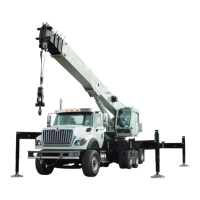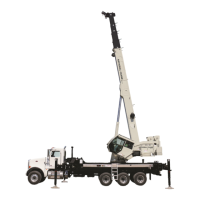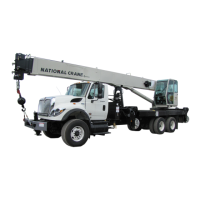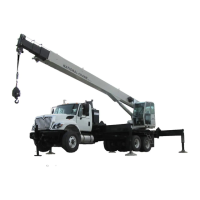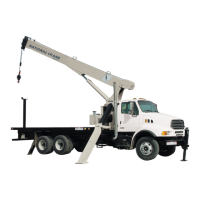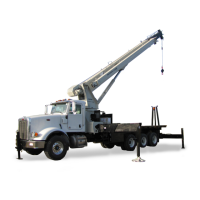NATIONAL CRANE Published 11-01-2020 Control # 710-00 6-5
NBT60XL OPERATOR MANUAL MAINTENANCE CHECKLIST
• Inspect rope in areas subjected to rapid deterioration
such as:
- Sections in contact with saddles, equalizer sheaves,
or other sheaves where rope travel is limited.
- Sections of wire rope at or near terminal ends where
corroded or broken wires may protrude.
- Sections in contact with stationary surfaces where
abrasion or chafing may take place as a result of
equipment vibration.
• Inspect boom nose sheaves, hook block sheaves, jib/
extension sheaves, auxiliary boom nose sheaves, and
hoist drums for wear. Damaged sheaves or hoist drums
can accelerate wear and cause rapid deterioration of the
rope.
Inspect the wedge socket of the rope for greater wear than
the rest of the rope. If the rope is in good condition, reverse
the rope on the drum so that the wear is equalized along the
total length of the rope.
Wire Rope Replacement
No precise rules can be given for determination of the exact
time for replacement of wire rope since many variable factors
are involved. Determination regarding continued use or
replacement of wire rope depends largely upon the good
judgement of an appointed and qualified person who
evaluates the remaining strength in a used rope after
allowance for any deterioration disclosed by inspection.
• Wire rope replacement should be determined by the
following information excerpted from a National
Consensus Standard as referenced by Federal
Government Agencies and as recommended by
National Crane. All wire rope will eventually deteriorate
to a point where it is no longer usable. Wire rope shall be
taken out of service when any of the following conditions
exist:
• Six randomly distributed broken wires in one rope lay or
three broken wires in one strand in one lay. The rope is
unsafe for further use if there are either three broken
wires in one strand (Breaks 2, 3, 4) or a total of six
broken wires in all strands in any one lay.
• In rotation resistant ropes: two randomly distributed
broken wires in six rope diameters or four randomly
distributed broken wires in 30 rope diameters
• Wear of one-third the original diameter of outside
individual wires. Worn rope, usually indicated by flat
spots on the outer wires is unsafe for further use when
less than two-thirds the thickness of the outer wire
remains.
• Necking down of the rope indicates core failure.
• Kinking, crushing, bird caging, or any other damage
resulting in distortion of the rope structure.
• Evidence of heat damage.
• Reductions from nominal diameter of more than 5%:
- 0.4 mm (0.0156 in) for rope diameters to 8 mm
(0.313 in)
- 0.8 mm (0.031) for rope diameters 9.5 mm (0.375
in) to 0.50 in (12.7 mm)
- 1.2 mm (0.047 in) for rope diameters 14.3 mm
(0.561 in) to 19.1 mm (0.75 in)
- 1.6 mm (0.063) for rope diameters 22.2 mm (0.875
in) to 28.6 mm (1.125 in).
• One outer wire broken at its point of contact with the core
of the rope which has worked its way out of, and
protrudes or loops out from the rope structure.
• National Crane recommends that for cable extended
booms, a single damaged wire rope assembly shall
require replacement of the complete set of extension
cables.
• National Crane recommends that boom extension
cables be replaced every seven (7) years.
Care of Wire Rope
Handle wire rope with care to prevent damage to the
individual wires which affect the overall strength and
performance of the rope. Do not allow the formation of kinks,
because this displaces the strands of wire from their original
position and relation to each other causing severe bending
and unequal tensions in the strands. This distortion and wire
displacement cannot be corrected even under high tension
and a permanent weak point remains in the rope. Displaced
or raised wires indicate a previous kink, but does not show
the damaged condition of the inner rope wires.
Never pull wire rope over a non-rotating support such as a
spindle bar, a pin, or an inoperative sheave. This practice
causes severe abrasion to the outer strand wires. A properly
Fo
r
Reference
Only
